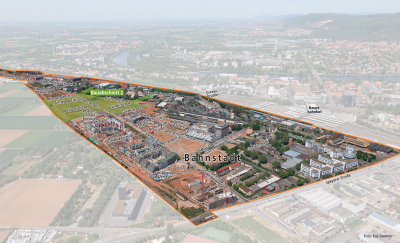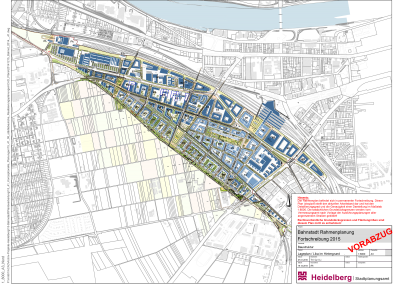Bahnstadt Heidelberg
The urban district Bahnstadt in Heidelberg is a conversion of former railway premises into one of the largest Passive Houses estate in Europe which is supplied with renewable energy. The aim is to achieve a zero-emission housing estate.
The new urban district covers an area of 116ha is targeted to provide accommodation for about 12000 occupants and 7000 workplaces built according to the Passive House Standard (offices and university-related services such as laboratories, retail (food and non-food), restaurants, hotels and cafés). This district is supplied by a biomass cogeneration plant (woodchips). The official opening took place on 16, April 2014.
The project team consists of the City of Heidelberg, the principal developer EGH (Entwicklungsgesellschaft Heidelberg (Heidelberg Development Association)).
The innovation is the Zero-emission standard (or CO2 neutral) for this large-scal urban district development for commercial and residential use built to the Passive House standard. The PH standard must be verified by the PHPP (Passive House Planning Package). Building approval will not be given without the PHPP.
Prior to this, a free consultation relating to energy-efficiency will be elucidated. The energy-efficiency concept also includes the topic of "electricity saving", which also constitutes a part of the consultation. Information are made publicly available by means of the internet website of bahnstadt Heidelberg.
The PHPP as a requirement for energetic design and quality control, airtightness concept and concepts for prevention of thermal bridges. Documentation of flow rate adjustment ventilation systems and airtightness test are compulsory. PHPP must be accepted by the City and inspection of the building sites, e.g. thickness of insulation, examination of main components, final acceptance, testing of the building components and technical inspection
Traffic: Good local public transport connections including trams and buses, new cycle routes, separate network of cycle routes to the university, additional routes on bridges over the railway tracks. Useful space will be freed up by means of underground car parking under buildings.
Nature conservation: Green roofs will be compulsory, rainwater retention systems, seepage of rainwater into the earth on the premises (50% of the total amount of rainwater will seep into the earth)
Decreased land use: Less land will be used because this is converted land use, higher proportion of free land due to compact development
Soil management: Least possible soil will be moved away from the area, excavated earth will remain in the Bahnstadt area as far as possible.
Political decision-making of the Bahnstadt project
The political decision in favour of the Bahnstadt Project within the urban development context was made by the municipal council of the City of Heidelberg in Autumn 2007 (Appendix 2 of this material: 0393/2007/BV). See the link below regarding urban planning (Städtebauliche Rahmenplanung) “Bahnstadt 2007“, in which the various aspects of the Bahnstadt development are set out.)
In 2008 the municipal council of the City of Heidelberg added a binding commitment for the urban development concept for energy and heat supply (see link below) (Appendix I of this material: 0080/2008/BV), and an urban development contract was made with the EGH (Heidelberg Development Association) for creating the infrastructure and a requirement for investors to build Passive Houses on a large scale.
A recommendation was made to the public utilities company of the City of Heidelberg (public services), which led to voluntary adoption of the energy concept with reference to the district heat connection and biomass cogeneration plant within the context of business principles.
According to the German development law for communities, the City of Heidelberg has the right to initiate long-term urban development. Since buildings already exist in a part of the new quarter, the City of Heidelberg will apply this law to the extent that existing buildings which need to be reconstructed are built to the Passive House Standard.
General information of the Bahnstadt
Framework of urban planning for „Bahnstadt 2007“ (German language)
Public areas in „Bahnstadt Heidelberg“, squares, parks and esplanades (German language)
Preparatory Investigations to the urban development measure (German language)
Bahnstadt Brochure (German language)
Energy concept of Heidelberg 2010 (Stadt Heidelberg 2010, “Energiekonzeption der Stadt Heidelberg”, The City of Heidelberg, Environmental Protection Bureau, Trade Supervision and Energy, City Council resolution)
Energy-efficiency concept of the Bahnstadt
Energy-efficiency concept (ebök 2007, “Baugebiet Bahnstadt in Heidelberg – Städtebauliches Energie- und Wärmeversorgungskonzept”, German language)
Folder Energy conservation (German language)
Quality assurance in the Bahnstadt
Passive House Standard: Quality Assurance for Residential Buildings (German language)
Passive House Standard: Quality Assurance for Non-Residential Buildings (German language)
Electricity saving concepts of the Bahnstadt
General report on energy saving (German language)
Electricity saving in the sector housing (German language)
Electricity saving in the sector offices (German language)
Electricity saving in the sector laboratories (German language)
Electricity saving in the sector retail/specialist stores (German language)
Bahnstadt Campus
General Campus brochure (English language)
General Campus brochure (German language)
More information

